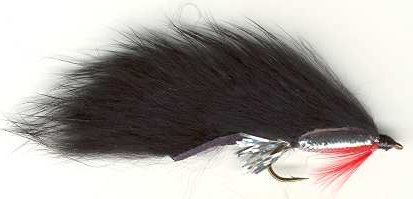The Black Zonker Streamer
Zonker streamer Mylar tubing imitates the scales on a bait fish's stomach and reflects light to grab the attention of nearby hungry bass, trout, steelhead or salmon.

ZONKER STREAMER FLY PATTERNS. Hook size 8 10 - $US each
ZONKERS - BIG FISH FLIES
The American fly fisherman Dan Byford invented the "minnow" shaped Zonker as a lively imitation of small baitfish fish. It is now a classic streamer fly pattern. In the 1970’s when Dan’s design was first publicized streamers were only tied using feathers or bucktail for wings. Dan’s use of Rabbit fur strips as a wing fly tying material was a radical move. He observed that the fur gave the fly a natural swimming movement when retrieved or fished dead drifted. The fly wiggles and undulates realistically when wet. Because the rabbit fur was tied still attached to the skin it provided a strong robust wing. The body on Dan Byford’s original fly design used metal sheeting folded over the hook to mimic the shiny under body of most baitfish and the rabbit fur strip imitated the fish’s darker colored back. Many smaller fish like Sticklebacks Kokenee, Suckers, juvenile larger fish, White fish, and Squaw Fish have a distinct line along their body between their darker back and a lighter tummy. This is why the Zonker is such a good design. The junction of the rabbit fur strip and the silver or gold mylar imitates this effect exactly. With the arrival of Mylar tubing in gold or silver as a fly tying material and its use on the Zonker fly pattern a more realistic imitation was obtained due to the weave of the Mylar tubing resembling fish scales.
The Red and Yellow Zonkers are attractors streamer fly patterns. Attractors do not represent a particular baitfish. They are designed to excite a predatory trout into striking using brightly colored and reflective materials in their design. Some fishermen call them ‘piss them off flies’ If you can get this type of fly to invade your target fish’s territory or personal space he may be stimulated to attack it. The Black, Olive, Natural and White Zonker falls within this group of streamers called imitator streamers. They try to represent a specific type of food, which is preyed upon by the trout. Trout are territorial and will defend their territory against invading fish. This fact can be used by fly-fishermen to their advantage. A brightly coloured attractor fly retrieved past the nose of a large brown trout in hiding in an undercut river bank can excite a trout into striking if it thinks its feeding territory is under attack. Trout also appear to strike out of simple curiosity just to see if it is edible even though it does not look like their normal food. Sometimes bright, flashy flies drive them crazy or just annoy them.
One of the biggest mistakes committed by fly fishermen fishing streamers is to retrieve the fly so it appears to swim directly towards the fish. This is guaranteed to spook a large fish who normally expects to see smaller fish fleeing from the vicinity of its hungry mouth. A three inch baitfish charging a large fish is not normal and will terrorize even the biggest trophy fish. You have to think like a small fish who is constantly in danger of being eaten by bigger fish. You must make your streamer fly behave like it is under attack and trying to escape from a hungry charging predator. Small fish instinctively know that they cannot swim against the current up stream to escape from a fast moving predator. So make sure it flees down stream. If near large rocks, an undercut river bank or thick weed they will swim for protective cover. Some will even hurl themselves out of the water to try and escape being eaten.
Do not cast a streamer across and down and then strip it back. This causes the fly to behave exactly opposite from a natural bait fish by swimming directly against the current. It may take the an occasional fish but it does not give the hunting trout a good broadside look at your streamer fly. All it sees is the back of the fly. Zonkers have the general shape and colouration of a real fish. Try to place your fly sideways onto the fish. Most streamer flies look the same from the rear. Let the fish see that your fly looks like a baitfish that may taste good. When it moves towards the fly that is the time to imitate the escaping spooked baitfish.
I have observed that many large trout first hit a small fish to disable and stun it. They then come back for the kill. It seems they like to disable their prey so they can devour it head first. Rather than getting the tail and fins stuck in its throat. A number of inexperienced fly fishermen end up with "short strikes" because the try to set the hook the first time they feel a hit. Waiting to strike at the proper moment for a sure hook up. Many fish don't like to move from their resting positions when the sun is high. I have found that streamer flies work best when the sun is off the water, or during the early morning and late evening. Zonkers are ideal for Largemouth Bass, Small Mouth Bass, Bull Trout, Brook Trout, Pike, Rainbows, Brown Trout, Steelhead, Coho, Chinook, Tarpon, Stripers, Snook, Jacks, Bonito and Mackerel.
CUSTOMER'S COMMENT
I fish many Northumbrian reservoirs. They all have a definite peat stain to them and this reduces visibility. I find that the most effective patterns in these conditions are large black streamer patterns like the black Zonker. They provide a strong silhouette that trout can locate easily and follow. The silver body not only imitates the natural juvenile fish’s silver tummy but also reflects any available light. - Hugh Tosh
Fly Fishing books


